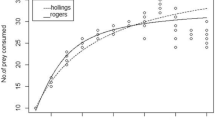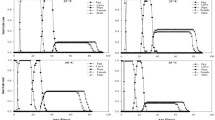Abstract
Functional response of the predator Chilocorus cacti (Linnaeus) (Coleoptera: Coccinellidae) on five densities of Dactylopius opuntiae (Cockerell) (Hemiptera: Dactylopiidae) female adults was assessed under laboratory conditions. The searching efficiency of C. cacti significantly decreased as prey density increased. The logistic regression for the predator had a negative and significant linear parameter indicating a type II functional response. Non-linear regression for Holling predator equation estimated a handling time of 1.79 ± 0.129 h and attack rate coefficient of 0.1003 ± 0.030. Most of this handling time was because the predator spent a lot of time removing the waxy coating that protects adult females of D. opuntiae. Chilocorus cacti consumes females of D. opuntiae in their reproductive stage; therefore, it could be an effective natural enemy to suppress or regulate low density populations of D. opuntiae, preventing them to reach high densities.



Similar content being viewed by others
References
Badii HM, Flores EA (2001) Prickly pear cacti pests and their control in Mexico. The Fla Entomol 84:503–505
Barberra G (1995) History, economic and agro-ecological importance of cactus pear. In: Barberra G, Inglese P, Pimienta-Barrios E (eds) Agro-ecology, cultivation and uses of cactus pear. Paper 132, FAO Plant Production and Protection, Rome, pp 1–11
Brutsch MO, Zimmermann HG (1993) The prickly pear (Opuntia ficus-indica) (Cactaceae) in South Africa: utilization of the naturalized weed, and of the cultivated plants. Econ Bot 47:154–162
Casas J, Hullinger B (1994) Statistical analysis of functional response experiments. Biocontrol Sci Technol 4:133–145
Collins MD, Wards S, Dixon AFG (1981) Handling time and the functional response of Aphelinus thomsoni, a predator and parasite of the aphid Drepanosiphum platanoides. J Anim Ecol 50:479–489
Defelice MS (2004) Prickly pear cactus, Opuntia spp.: a spine-tingling tale. Weed Technol 18:869–877
Elliot JM (2003) A comparative study of the functional response of four species of carnivorous stoneflies. Freshw Biol 48:191–202
Fenlon JS, Malcolm JF (2006) Modelling predation in functional response. Ecol Model 198:154–162
Fernández-Arhex VY, Corley JC (2004) La respuesta funcional: una revisión y guía experimental. Ecol Austral 14:83–93
Flores MA, Rodríguez NS, Ramos EM, Payán ZF (2010) Estudio de Harmonia axirydis Pallas (Coleoptera: Coccinelidae) como bioagente de control de Aphis gossypii Glover (Hemiptera: Aphididae). Interciencia 35:506–509
Githure CW, Zimmermann HG, Hoffmann JH (1999) Host specificity of biotypes of Dactylopius opuntiae (Cockerell) (Hemiptera: Dactylopiidae): prospects for biological control of Opuntia stricta (Haworth) Haworth (Cactaceae) in Africa. Afr Entomol 7:43–48
Griffith MP (2004) The origins of an important cactus crop, Opuntia ficus-indica (Cactaceae): new molecular evidence. Am J Bot 91:1915–1921
Gunog S, Donald LD (2011) A predator–prey model with a Holling type I functional response including a predator mutual interference. J Nonlinear Sci 21:811–833
Hassell MP (2000) The spatial and temporal dynamics of host-parasitoid interactions. Oxford University Press, Oxford
Hassell MP, Lawton JH, Beddington JR (1977) Sigmoid functional response by invertebrate and parasitoids. J Anim Ecol 46:249–262
Holling CS (1959) Some characteristics of simple types of predation and parasitism. Can Entomol 91:385–398
Hosking JR, Sullivan PR, Welsby SM (1994) Biological control of Opuntia stricta (Haw.) Haw. var. stricta using Dactylopius opuntiae (Cockerell) in an area of New South Wales, Australia, where Cactoblastiscactorum (Berg) is not a successful biological control agent. Agric Ecosyst Environ 48:241–255
International Biological Programme (1976) Studies in biological control. V.L. Deluchi (ed). Syndics of the Cambridge University Press, London
Isikber AA (2005) Functional response of two coccinellid predators, Scymnus levaillanti and Cycloneda sanguinea, to the cotton aphid, Aphis gossypii. Turk J Agric Forestry 29:347–355
Juliano SA (2001) Non-linear curve fitting: predation and functional response curves. In: Scheiner SM, Gurevitch J (eds) Design and analysis of ecological experiments, 2nd edn. Chapman and Hall, New York, pp 178–196
Juliano SA, Williams FM (1987) A comparison of methods for estimating the functional response parameters of the random predator equation. J Anim Ecol 56:641–653
Kratina P, Vos M, Bateman A, Anholt BR (2007) Species diversity modulates predation. Ecology 88:1917–23
Kratina P, Vos M, Bateman A, Anholt BR (2009) Functional responses modified by predator density. Oecologia 159:425–433
Murdoch WW, Oaten A (1975) Predation and population stability. Adv Ecol Res 9:1–131
O’Connell DM, Wratten SD, Pugh AR, Barnes A-M (2012) ‘New species association’ biological control? Two coccinellid species and an invasive psyllid pest in New Zealand. Bio Control 62:86–92
Oliveira E, Oliveira CL, Sarmento RA, Rezende LM, Fadini MAM (2004) Aspectos biológicos do predador Cycloneda sanguinea (Coleoptera: Coccinellidae) alimentado com Tetranychus evansi (Acari: Tetranychidae) e Macrosiphum euphorbiae (Homoptera: Aphididae). Biosci J 21:33–39
Omkar Pervez A (2004) Functional and numerical responses of Propylea dissecta (Mulsant) (Col., Coccinellidae). J Appl Entomol 128:140–146
Pervez A, Omkar (2003) Predation potential and handling time estimates of a generalist ladybird beetle, Propylea dissecta. Biol Mem 29: 91-97
Pervez A, Omkar (2005) Functional responses of coccinellid predators: an illustration of a logistic approach. J Insect Sci 5(5): 1–6. Available online: insectscience.org/5.5
Rocha LDA, Redaelli LR (2004) Functional response of Cosmoclopius nigroannulatus (Hem.: Reduviidae) to different densities of Spartocera dentiventris (Hem.: Coreidae) nymphae. Braz J Biol 64:309–316
Rogers D (1972) Random search and insect population models. J Anim Ecol 41:369–383
SAS (2001) SAS user’s guide: statistics. SAS Institute Inc. Version 8, North Carolina, USA
Trexler JC, Maculloch CE, Travis J (1988) How can the functional response best be determined? Oecologia 76:206–214
Vanegas RJM, Lomeli FJR, Rodríguez LE, Mora AG, Valdez JM (2010) Enemigos naturales de Dactylopius opuntiae (Cockerell) en Opuntia Ficus-Indica (L.) Miller en el centro de México. Acta Zool Mex 26:415–433
Wiedenmann RN, O’neil RJ (1991) Laboratory measurement of the functional response of Podisus maculiventris (Say) (Heteroptera, Pentatomidae). Environ Entomol 20:610–614
Williams FM, Juliano SA (1985) Further difficulties in the analysis of functional response experiments and a resolution. Can Entomol 117:605–616
Zimmermann HG, Moran VC (1991) Biological control of prickly pear, Opuntia ficus-indica (Cactaceae), in South Africa. Agric Ecosyst Environ 37:29–35
Acknowledgments
The authors wish to thank to Dr. Refugio Lomelí Flores, Colegio de Posgraduados, Montecillo, Mexico, for confirming the insect identification and providing helpful suggestions.
Author information
Authors and Affiliations
Corresponding author
Additional information
Edited by Madelaine Venzon – EPAMIG
Rights and permissions
About this article
Cite this article
Flores, A., Olvera, H., Rodríguez, S. et al. Predation Potential of Chilocorus cacti (Coleoptera: Coccinellidae) to the Prickly Pear Cacti Pest Dactylopius opuntiae (Hemiptera: Dactylopiidae). Neotrop Entomol 42, 407–411 (2013). https://doi.org/10.1007/s13744-013-0139-z
Received:
Accepted:
Published:
Issue Date:
DOI: https://doi.org/10.1007/s13744-013-0139-z




